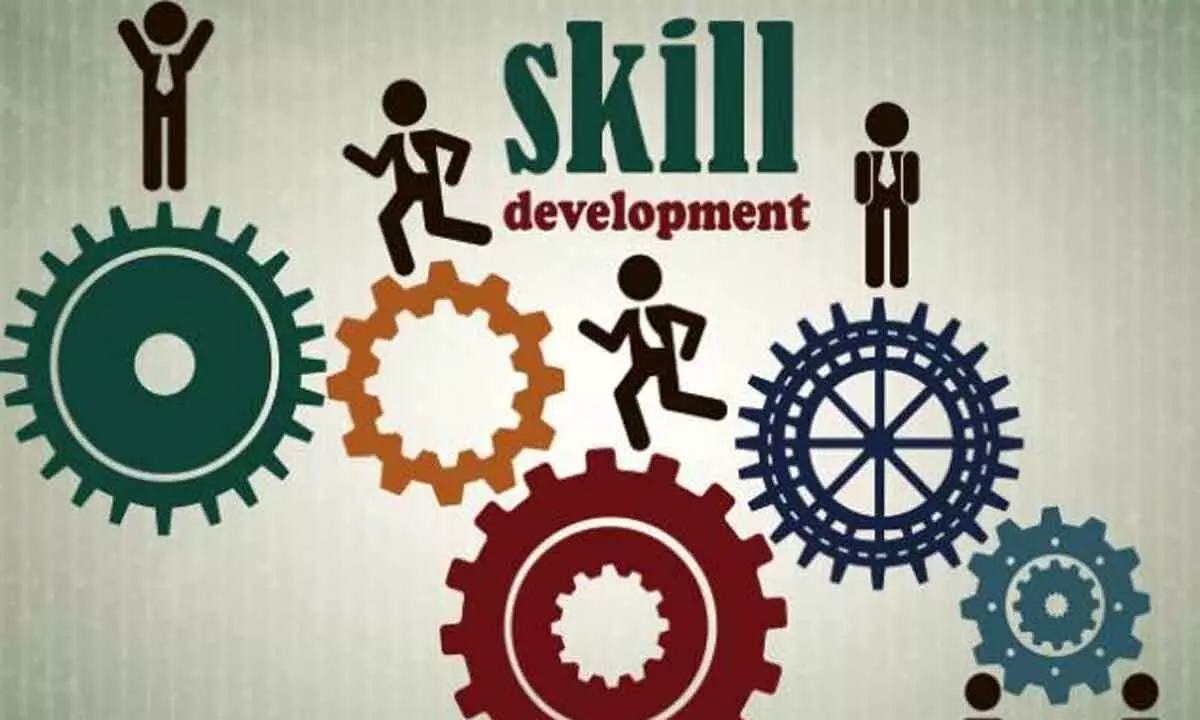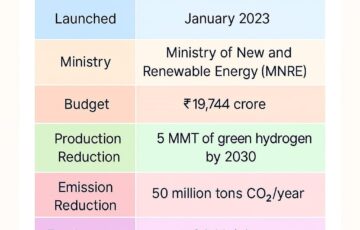India’s circular migration: Bridging global skill gaps
Syllabus:
GS-2: Human ResourceGovernment Policies & Interventions
GS- 3: Skill DevelopmentGrowth & Development
Focus:
India’s focus on plugging the global skill gap has gained momentum through government-to-government agreements, enabling skilled migration. With countries like Israel, Japan, and Germany facing workforce shortages due to ageing populations, India is leveraging its vast human capital to meet global labour demands.
India’s Circular Migration and Skill Development Initiatives:
- India’s circular migration system ensures that skilled workers return after working abroad, thus preventing brain drain.
- 997 youth from Maharashtra, with only high school certificates, are set to work in Israel with a monthly salary of ₹1.37 lakh, under a labour mobility agreement.
- Circular migration benefits both India and host countries like Israel, Japan, and Germany, as it fills their skill gaps while enhancing India’s workforce.
- Unlike permanent migration, where highly qualified professionals settle abroad, circular migration promotes skill transfer back to India.
- High-income professionals in countries like the US contribute less to India’s remittances compared to manual workers in Gulf nations, reinforcing the value of labour migration agreements.
Government Measures for Skill Development
- Skill Development Initiatives
- Pradhan Mantri Kaushal Vikas Yojana (PMKVY): Offers skill training through Short-Term Training (STT) and Recognition of Prior Learning (RPL) for youth across India.
- Jan Shikshan Sansthan (JSS) Scheme: Vocational skills for non-literates, neo-literates, and school dropouts aged 15-45, with special focus on Divyangjan.
- Policy and Apprenticeship Programs
- National Policy on Skill Development & Entrepreneurship (NPSDE): Aims to bridge skill gaps, enhance industry engagement, and expand apprenticeships.
- National Apprenticeship Promotion Scheme (NAPS): Provides financial support to industries for apprenticeship training.
- Long-Term Training and Financial Support
- Craftsmen Training Scheme (CTS): Offers long-term training through Industrial Training Institutes (ITIs).
- Model Skill Loan Scheme: Loans of up to ₹7.5 lakh for skill development with government-backed guarantees.
- Employment-Linked Incentives and Digital Platforms
- Employment-Linked Incentive Schemes: Support for employees and employers, targeting 1 crore youth over five years with EPFO-linked incentives.
- Digital Initiatives: Platforms like National Career Service (NCS) provide online training and career counselling.
- International Migration and Collaboration
- Bilateral Agreements: Skill training and certification programs with countries like Germany, France, and Japan to meet labour shortages and facilitate skilled migration.
Global Migration and Historical Context:
- Migration has historically shaped cultures, particularly in regions like the Americas and Australia, where European settlers moved freely.
- Europe, with its vast resources, alleviated poverty through such migration, while China expanded westward, securing resources.
- India’s geographic barriers—Himalayas in the north and oceans in the south—led to a civilization that welcomed migrants rather than colonised other lands.
- Mass migration is now limited due to strict border controls, but India’s large workforce remains underutilised.
- As developed countries, like those in Western Europe and Japan, face an ageing population crisis, they look to countries like India to fill their skill shortages.
Opportunities in Ageing Economies
- The ageing population in Europe and Japan presents a major opportunity for India to supply skilled workers, particularly in healthcare, IT, and construction.
- Europe faces a shortage of workers to manage advanced technologies like quantum computing and infrastructure development.
- Germany’s Federal Minister for Economic Affairs highlighted workforce shortages as a constraint to economic growth, emphasising the need for skilled migration.
- Bilateral agreements between India and non-English-speaking countries, such as Israel and Japan, aim to address their skill deficits with Indian talent.
- These agreements ensure workers are well-compensated and protected, with guaranteed social security and return to India after the contract period.
Benefits of Government-to-Government Agreements
- Government-to-government (G-to-G) agreements streamline the process of skill migration by ensuring legal protections for workers.
- These agreements safeguard wages, provide social security, and guarantee the return of Indian workers after their contracts abroad.
- Countries like Israel, Japan, and Germany have specific labour demands, which are addressed through these bilateral agreements.
- G-to-G agreements also help standardise the skill-matching process, ensuring workers are
- equipped with the exact skills required.
- These partnerships further strengthen India’s global relations while benefiting its economy through remittances and upskilled labour.
The Role of Language and Cultural Training:
- Language barriers are a significant challenge in deploying skilled workers to non-English-speaking countries like Japan and Germany.
- To overcome this, India is offering language training in Japanese, German, and French to prepare its workforce for global markets.
- Cultural orientation programs are also provided to ensure Indian workers can adapt to the work environment abroad.
- These initiatives enhance employability and increase the chances of successful placements in foreign countries.
- By addressing both language and cultural gaps, India ensures its workers are competitive and efficient in international labour markets.
Skill Development and Placement Programs:
- India’s skill development programs include Recognition of Prior Learning (RPL) courses, which help workers upgrade their skills to meet international standards.
- In Maharashtra, construction workers in trades like plastering, tiling, and formwork were shortlisted for jobs in Israel based on pre-selection tests.
- MITRA organised booster training in English and construction skills to give workers a competitive edge in tests conducted by the Israel Builders Association.
- The Ministry of External Affairs and regional passport officers worked to fast-track passport applications, with financial assistance provided for those in need.
- Testing facilities were set up in Pune to match Israeli requirements, with innovative solutions like fabricating specific machines needed for bar bending.
Challenges in Fulfilling Global Skill Gaps:
- Although India has the workforce numbers, aligning skills with international demands is challenging due to language and skill-certification barriers.
- Government-to-government agreements focus on exact skill-matching and legal compliances like passport issuance and visa regulations.
- The National Skill Development Corporation (NSDC) has been instrumental in aggregating skill demand from partner countries and providing suitable training.
- In Maharashtra, MITRA collaborated with the NSDC and state departments to create standard operating procedures for accessing global wage markets.
- A key challenge was identifying large numbers of youth with the exact skills required and preparing them through additional training and certification programs.
The Future of Circular Migration and India’s Role:
- Circular migration agreements ensure that Indian workers return with advanced skills, benefiting domestic industries, particularly in construction and IT.
- The experience gained by Indian workers abroad in using sophisticated machinery and management protocols will enhance their employability upon returning home.
- MITRA is working with the Maharashtra government to create a dynamic database of skilled youth ready to meet global demands from countries like Japan, Germany, and Israel.
- India’s future lies in positioning itself as a global source of human capital, leveraging skill deficits in ageing economies to enhance its domestic workforce.
- As barriers to labour mobility dissolve, driven by international demand, India’s skilled workers will play a critical role in sustaining global economies while improving their own country.
Way Ahead for Skill Development and Global Labour Demand:
- Understanding Global Labour Demand
- Market Research: Conduct in-depth studies on labour shortages in developed economies.
- Strategic Alignment: Create policies that align Indian workforce skills with global demands through targeted training programs.
- Skill Development
- Investment in Education: Increase funding for education and vocational training to improve curriculum and teaching quality.
- Industry Partnerships: Collaborate with industries to ensure training meets current job market needs.
- Certification: Implement globally recognized certification systems to boost employability abroad.
- International Agreements
- Bilateral and Multilateral Agreements: Strengthen labour mobility agreements with other countries.
- Streamlined Immigration: Simplify visa processes to reduce bureaucratic barriers for Indian workers.
- Public Awareness
- Awareness Campaigns: Educate the public on the benefits of migration for economic growth.
- Success Stories: Showcase successful Indian migrants to inspire positive perceptions of labour mobility.
- Reducing Costs
- Transaction Cost Reduction: Lower costs such as visa fees to make migration more affordable.
- Reintegration Programs: Offer job placement and skill recognition services to returning workers.
- Women Empowerment
- Encouragement: Promote women’s participation through mentorship and flexible work options.
- Targeted Skill Development: Offer specialised training for women to enhance their employability.
Conclusion:
Government initiatives for skill development and circular migration are mutually beneficial for India and developed economies. These agreements enable Indian workers to acquire advanced skills abroad and bring them back home, fostering economic growth and enhancing India’s global role as a provider of skilled labour.
Source: The Indian Express
Mains Practice Question:
Discuss the significance of circular migration in addressing global skill gaps, and how India’s government initiatives can play a pivotal role in bridging these gaps while benefiting the domestic economy. (250 words)





